Cash Flow Issues of SME's Enterprises: Construction Sector in Australia
VerifiedAdded on 2023/03/30
|21
|4083
|438
AI Summary
This research proposal focuses on the cash flow issues faced by small and medium-sized construction enterprises in Australia. It discusses the challenges faced by these enterprises, such as slow invoicing and payment cycles, increasing costs of raw materials, lack of safety training and shortage of skilled labor. The proposal aims to determine the impact of these cash flow issues on the construction industry and the economy of Australia as a whole. It also aims to identify strategies that can be used to resolve these issues and improve cash flow management in SMEs. The research questions and objectives are outlined, and the expected outcomes of the research are discussed.
Contribute Materials
Your contribution can guide someone’s learning journey. Share your
documents today.
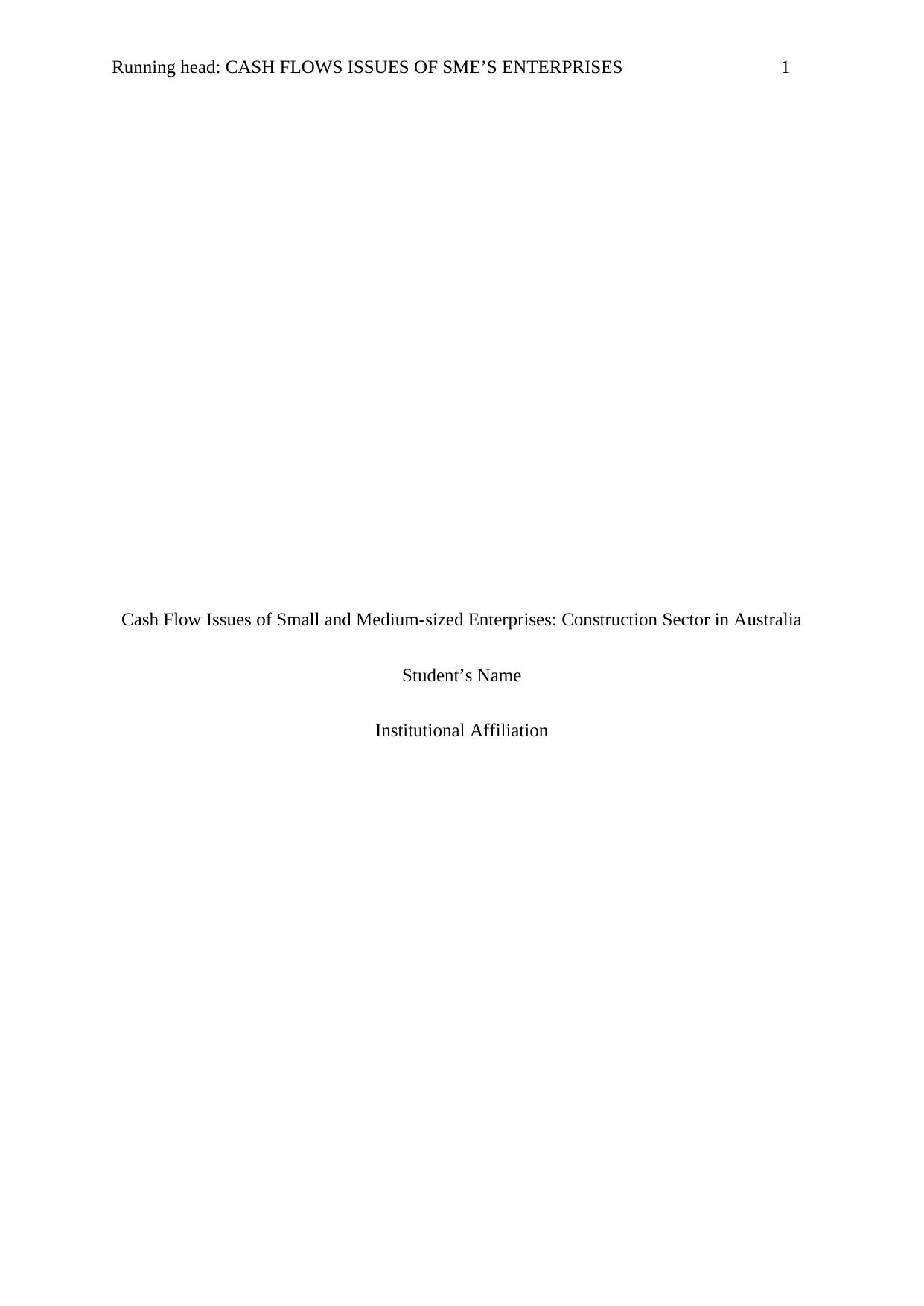
Running head: CASH FLOWS ISSUES OF SME’S ENTERPRISES 1
Cash Flow Issues of Small and Medium-sized Enterprises: Construction Sector in Australia
Student’s Name
Institutional Affiliation
Cash Flow Issues of Small and Medium-sized Enterprises: Construction Sector in Australia
Student’s Name
Institutional Affiliation
Secure Best Marks with AI Grader
Need help grading? Try our AI Grader for instant feedback on your assignments.
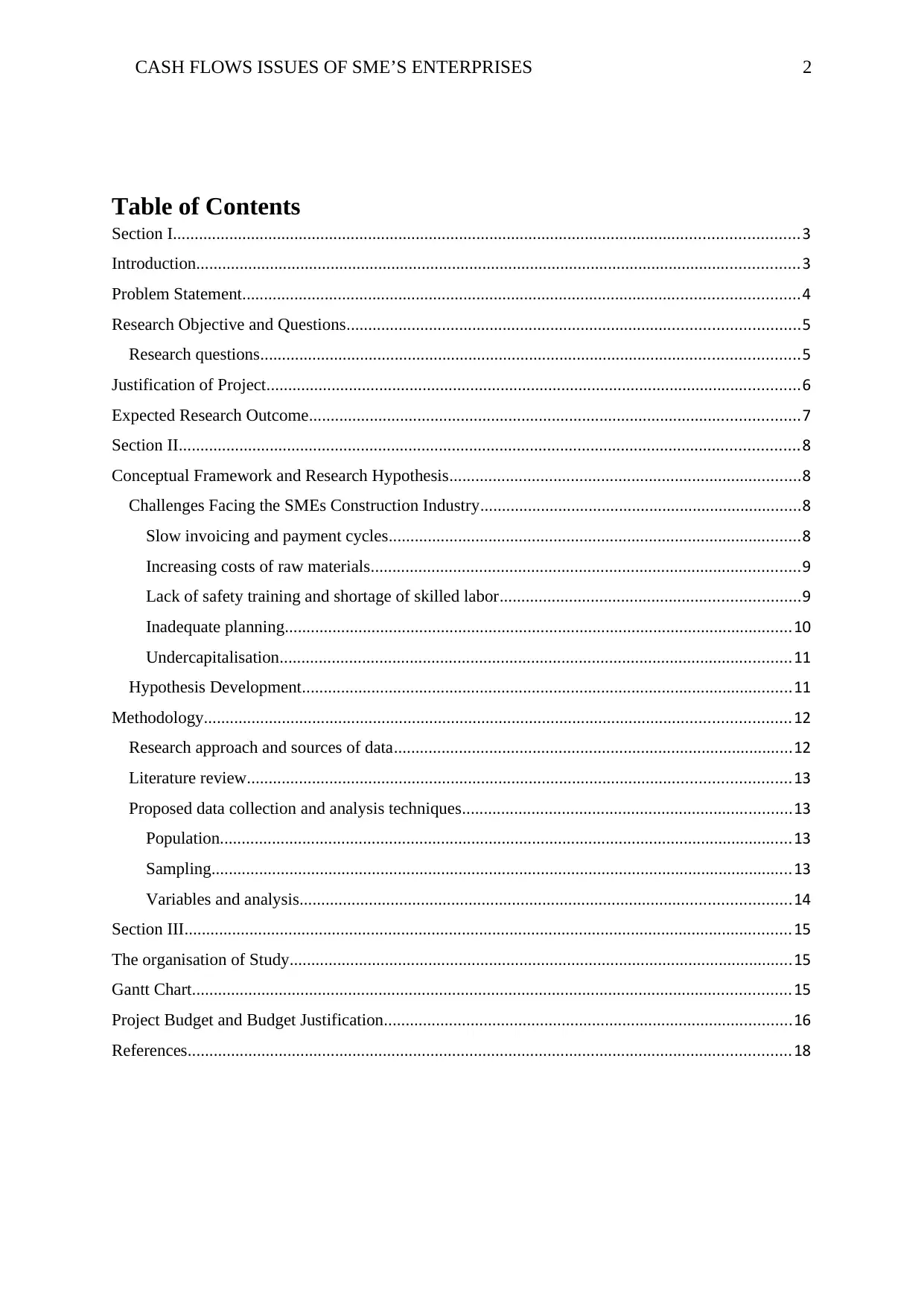
CASH FLOWS ISSUES OF SME’S ENTERPRISES 2
Table of Contents
Section I................................................................................................................................................3
Introduction...........................................................................................................................................3
Problem Statement................................................................................................................................4
Research Objective and Questions........................................................................................................5
Research questions............................................................................................................................5
Justification of Project...........................................................................................................................6
Expected Research Outcome.................................................................................................................7
Section II...............................................................................................................................................8
Conceptual Framework and Research Hypothesis.................................................................................8
Challenges Facing the SMEs Construction Industry..........................................................................8
Slow invoicing and payment cycles...............................................................................................8
Increasing costs of raw materials...................................................................................................9
Lack of safety training and shortage of skilled labor.....................................................................9
Inadequate planning.....................................................................................................................10
Undercapitalisation......................................................................................................................11
Hypothesis Development.................................................................................................................11
Methodology.......................................................................................................................................12
Research approach and sources of data............................................................................................12
Literature review.............................................................................................................................13
Proposed data collection and analysis techniques............................................................................13
Population....................................................................................................................................13
Sampling......................................................................................................................................13
Variables and analysis.................................................................................................................14
Section III............................................................................................................................................15
The organisation of Study....................................................................................................................15
Gantt Chart..........................................................................................................................................15
Project Budget and Budget Justification..............................................................................................16
References...........................................................................................................................................18
Table of Contents
Section I................................................................................................................................................3
Introduction...........................................................................................................................................3
Problem Statement................................................................................................................................4
Research Objective and Questions........................................................................................................5
Research questions............................................................................................................................5
Justification of Project...........................................................................................................................6
Expected Research Outcome.................................................................................................................7
Section II...............................................................................................................................................8
Conceptual Framework and Research Hypothesis.................................................................................8
Challenges Facing the SMEs Construction Industry..........................................................................8
Slow invoicing and payment cycles...............................................................................................8
Increasing costs of raw materials...................................................................................................9
Lack of safety training and shortage of skilled labor.....................................................................9
Inadequate planning.....................................................................................................................10
Undercapitalisation......................................................................................................................11
Hypothesis Development.................................................................................................................11
Methodology.......................................................................................................................................12
Research approach and sources of data............................................................................................12
Literature review.............................................................................................................................13
Proposed data collection and analysis techniques............................................................................13
Population....................................................................................................................................13
Sampling......................................................................................................................................13
Variables and analysis.................................................................................................................14
Section III............................................................................................................................................15
The organisation of Study....................................................................................................................15
Gantt Chart..........................................................................................................................................15
Project Budget and Budget Justification..............................................................................................16
References...........................................................................................................................................18
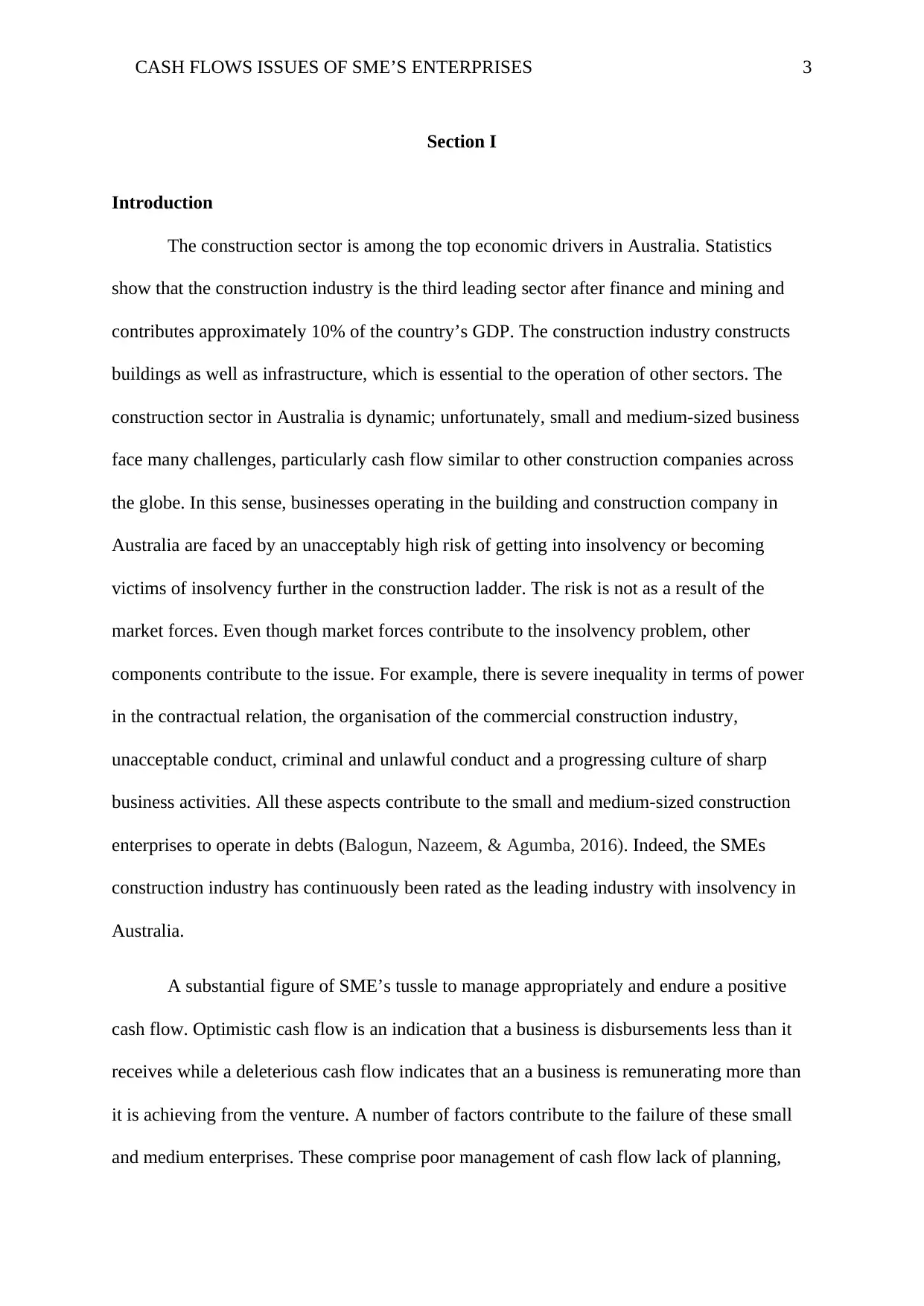
CASH FLOWS ISSUES OF SME’S ENTERPRISES 3
Section I
Introduction
The construction sector is among the top economic drivers in Australia. Statistics
show that the construction industry is the third leading sector after finance and mining and
contributes approximately 10% of the country’s GDP. The construction industry constructs
buildings as well as infrastructure, which is essential to the operation of other sectors. The
construction sector in Australia is dynamic; unfortunately, small and medium-sized business
face many challenges, particularly cash flow similar to other construction companies across
the globe. In this sense, businesses operating in the building and construction company in
Australia are faced by an unacceptably high risk of getting into insolvency or becoming
victims of insolvency further in the construction ladder. The risk is not as a result of the
market forces. Even though market forces contribute to the insolvency problem, other
components contribute to the issue. For example, there is severe inequality in terms of power
in the contractual relation, the organisation of the commercial construction industry,
unacceptable conduct, criminal and unlawful conduct and a progressing culture of sharp
business activities. All these aspects contribute to the small and medium-sized construction
enterprises to operate in debts (Balogun, Nazeem, & Agumba, 2016). Indeed, the SMEs
construction industry has continuously been rated as the leading industry with insolvency in
Australia.
A substantial figure of SME’s tussle to manage appropriately and endure a positive
cash flow. Optimistic cash flow is an indication that a business is disbursements less than it
receives while a deleterious cash flow indicates that an a business is remunerating more than
it is achieving from the venture. A number of factors contribute to the failure of these small
and medium enterprises. These comprise poor management of cash flow lack of planning,
Section I
Introduction
The construction sector is among the top economic drivers in Australia. Statistics
show that the construction industry is the third leading sector after finance and mining and
contributes approximately 10% of the country’s GDP. The construction industry constructs
buildings as well as infrastructure, which is essential to the operation of other sectors. The
construction sector in Australia is dynamic; unfortunately, small and medium-sized business
face many challenges, particularly cash flow similar to other construction companies across
the globe. In this sense, businesses operating in the building and construction company in
Australia are faced by an unacceptably high risk of getting into insolvency or becoming
victims of insolvency further in the construction ladder. The risk is not as a result of the
market forces. Even though market forces contribute to the insolvency problem, other
components contribute to the issue. For example, there is severe inequality in terms of power
in the contractual relation, the organisation of the commercial construction industry,
unacceptable conduct, criminal and unlawful conduct and a progressing culture of sharp
business activities. All these aspects contribute to the small and medium-sized construction
enterprises to operate in debts (Balogun, Nazeem, & Agumba, 2016). Indeed, the SMEs
construction industry has continuously been rated as the leading industry with insolvency in
Australia.
A substantial figure of SME’s tussle to manage appropriately and endure a positive
cash flow. Optimistic cash flow is an indication that a business is disbursements less than it
receives while a deleterious cash flow indicates that an a business is remunerating more than
it is achieving from the venture. A number of factors contribute to the failure of these small
and medium enterprises. These comprise poor management of cash flow lack of planning,
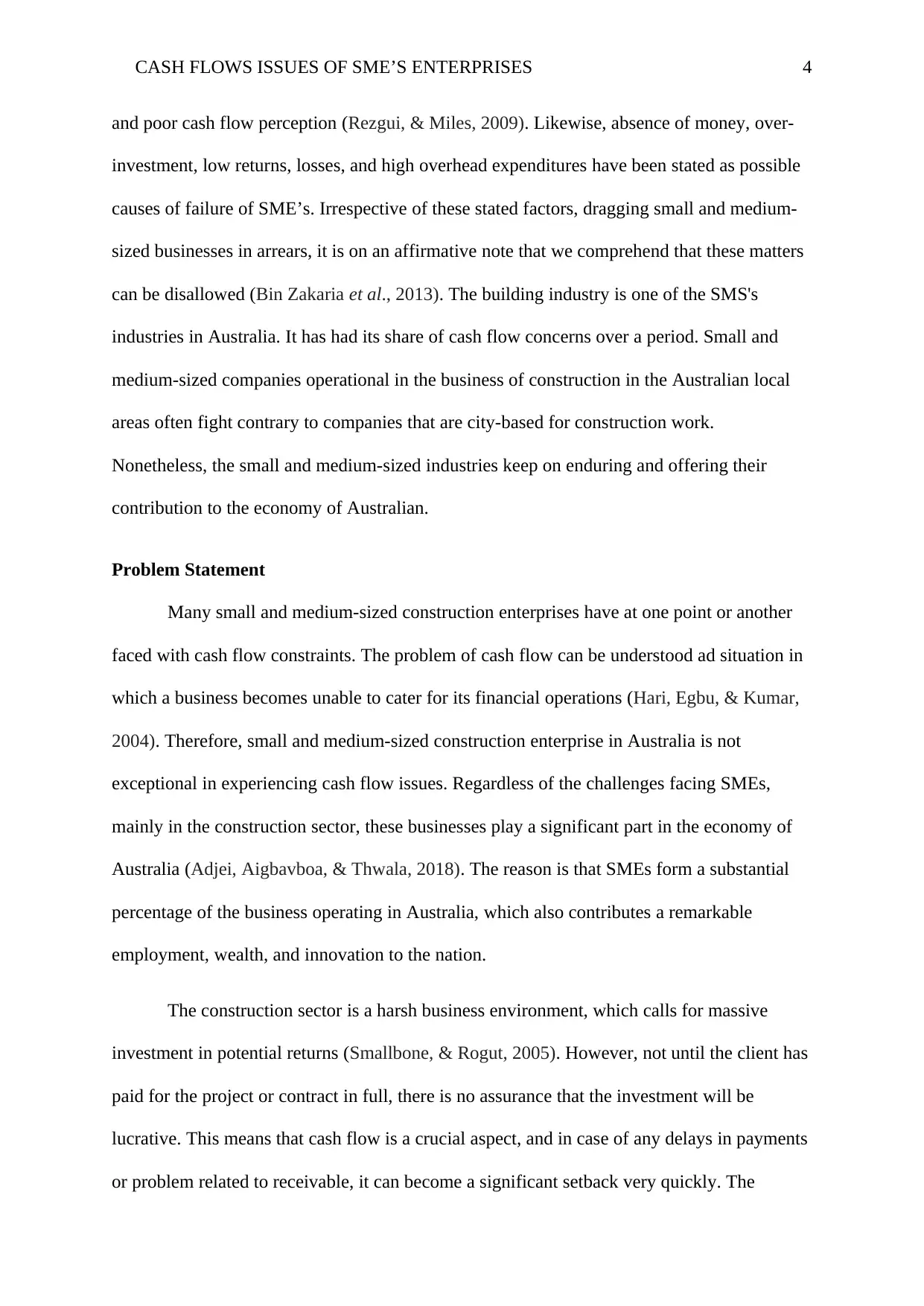
CASH FLOWS ISSUES OF SME’S ENTERPRISES 4
and poor cash flow perception (Rezgui, & Miles, 2009). Likewise, absence of money, over-
investment, low returns, losses, and high overhead expenditures have been stated as possible
causes of failure of SME’s. Irrespective of these stated factors, dragging small and medium-
sized businesses in arrears, it is on an affirmative note that we comprehend that these matters
can be disallowed (Bin Zakaria et al., 2013). The building industry is one of the SMS's
industries in Australia. It has had its share of cash flow concerns over a period. Small and
medium-sized companies operational in the business of construction in the Australian local
areas often fight contrary to companies that are city-based for construction work.
Nonetheless, the small and medium-sized industries keep on enduring and offering their
contribution to the economy of Australian.
Problem Statement
Many small and medium-sized construction enterprises have at one point or another
faced with cash flow constraints. The problem of cash flow can be understood ad situation in
which a business becomes unable to cater for its financial operations (Hari, Egbu, & Kumar,
2004). Therefore, small and medium-sized construction enterprise in Australia is not
exceptional in experiencing cash flow issues. Regardless of the challenges facing SMEs,
mainly in the construction sector, these businesses play a significant part in the economy of
Australia (Adjei, Aigbavboa, & Thwala, 2018). The reason is that SMEs form a substantial
percentage of the business operating in Australia, which also contributes a remarkable
employment, wealth, and innovation to the nation.
The construction sector is a harsh business environment, which calls for massive
investment in potential returns (Smallbone, & Rogut, 2005). However, not until the client has
paid for the project or contract in full, there is no assurance that the investment will be
lucrative. This means that cash flow is a crucial aspect, and in case of any delays in payments
or problem related to receivable, it can become a significant setback very quickly. The
and poor cash flow perception (Rezgui, & Miles, 2009). Likewise, absence of money, over-
investment, low returns, losses, and high overhead expenditures have been stated as possible
causes of failure of SME’s. Irrespective of these stated factors, dragging small and medium-
sized businesses in arrears, it is on an affirmative note that we comprehend that these matters
can be disallowed (Bin Zakaria et al., 2013). The building industry is one of the SMS's
industries in Australia. It has had its share of cash flow concerns over a period. Small and
medium-sized companies operational in the business of construction in the Australian local
areas often fight contrary to companies that are city-based for construction work.
Nonetheless, the small and medium-sized industries keep on enduring and offering their
contribution to the economy of Australian.
Problem Statement
Many small and medium-sized construction enterprises have at one point or another
faced with cash flow constraints. The problem of cash flow can be understood ad situation in
which a business becomes unable to cater for its financial operations (Hari, Egbu, & Kumar,
2004). Therefore, small and medium-sized construction enterprise in Australia is not
exceptional in experiencing cash flow issues. Regardless of the challenges facing SMEs,
mainly in the construction sector, these businesses play a significant part in the economy of
Australia (Adjei, Aigbavboa, & Thwala, 2018). The reason is that SMEs form a substantial
percentage of the business operating in Australia, which also contributes a remarkable
employment, wealth, and innovation to the nation.
The construction sector is a harsh business environment, which calls for massive
investment in potential returns (Smallbone, & Rogut, 2005). However, not until the client has
paid for the project or contract in full, there is no assurance that the investment will be
lucrative. This means that cash flow is a crucial aspect, and in case of any delays in payments
or problem related to receivable, it can become a significant setback very quickly. The
Secure Best Marks with AI Grader
Need help grading? Try our AI Grader for instant feedback on your assignments.
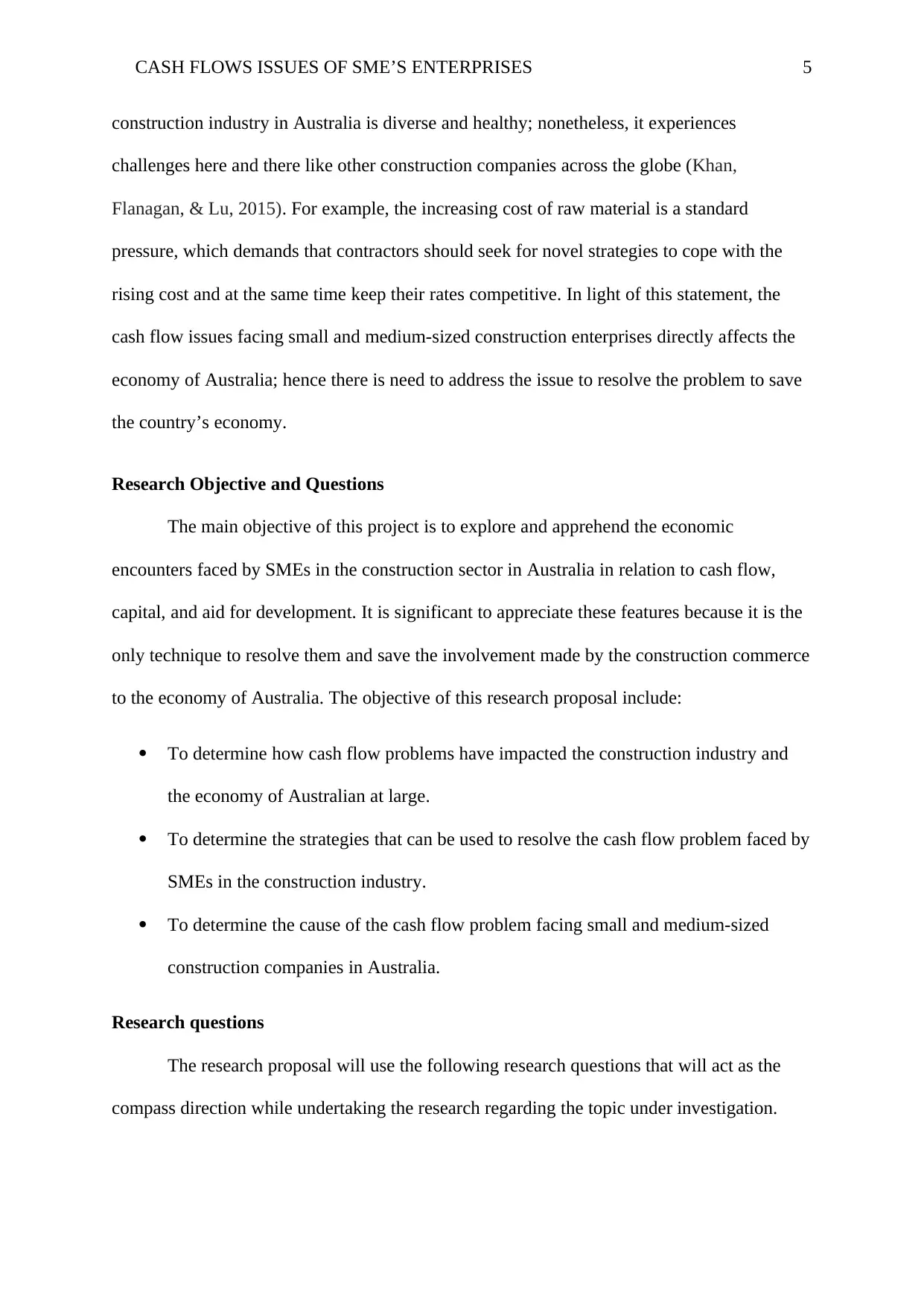
CASH FLOWS ISSUES OF SME’S ENTERPRISES 5
construction industry in Australia is diverse and healthy; nonetheless, it experiences
challenges here and there like other construction companies across the globe (Khan,
Flanagan, & Lu, 2015). For example, the increasing cost of raw material is a standard
pressure, which demands that contractors should seek for novel strategies to cope with the
rising cost and at the same time keep their rates competitive. In light of this statement, the
cash flow issues facing small and medium-sized construction enterprises directly affects the
economy of Australia; hence there is need to address the issue to resolve the problem to save
the country’s economy.
Research Objective and Questions
The main objective of this project is to explore and apprehend the economic
encounters faced by SMEs in the construction sector in Australia in relation to cash flow,
capital, and aid for development. It is significant to appreciate these features because it is the
only technique to resolve them and save the involvement made by the construction commerce
to the economy of Australia. The objective of this research proposal include:
To determine how cash flow problems have impacted the construction industry and
the economy of Australian at large.
To determine the strategies that can be used to resolve the cash flow problem faced by
SMEs in the construction industry.
To determine the cause of the cash flow problem facing small and medium-sized
construction companies in Australia.
Research questions
The research proposal will use the following research questions that will act as the
compass direction while undertaking the research regarding the topic under investigation.
construction industry in Australia is diverse and healthy; nonetheless, it experiences
challenges here and there like other construction companies across the globe (Khan,
Flanagan, & Lu, 2015). For example, the increasing cost of raw material is a standard
pressure, which demands that contractors should seek for novel strategies to cope with the
rising cost and at the same time keep their rates competitive. In light of this statement, the
cash flow issues facing small and medium-sized construction enterprises directly affects the
economy of Australia; hence there is need to address the issue to resolve the problem to save
the country’s economy.
Research Objective and Questions
The main objective of this project is to explore and apprehend the economic
encounters faced by SMEs in the construction sector in Australia in relation to cash flow,
capital, and aid for development. It is significant to appreciate these features because it is the
only technique to resolve them and save the involvement made by the construction commerce
to the economy of Australia. The objective of this research proposal include:
To determine how cash flow problems have impacted the construction industry and
the economy of Australian at large.
To determine the strategies that can be used to resolve the cash flow problem faced by
SMEs in the construction industry.
To determine the cause of the cash flow problem facing small and medium-sized
construction companies in Australia.
Research questions
The research proposal will use the following research questions that will act as the
compass direction while undertaking the research regarding the topic under investigation.

CASH FLOWS ISSUES OF SME’S ENTERPRISES 6
1. In what ways has the issue of cash flow affected the construction industry and the
economy of Australia as a whole?
2. Which strategies can be used to help resolve the cash flow issues faced by the SMEs
in the construction industry?
3. What is the cause of the cash flow problem facing small and medium-sized
construction companies in Australia?
Justification of the Project
Research about the cash flow issues facing small and medium-sized business in the
construction sector is essential to the economy of Australia because of the following reasons:
To begin with, small and medium-sized construction companies are vital contributors to the
economy of Australia, employing many Australians. Statistics by the Reserve Bank of
Australia (RBA) show that SMEs has offered employment to nearly 70% of the Australian
labor force. In this sense, it means that small and medium-sized construction companies have
contributed that percentage too. Indeed, small and medium-sized enterprises in most cases,
provide a lot of employment to opportunities to unskilled people, which aid in driving down
the rate of unemployment. Accordingly, this will be a constructive flow-on effect like the
decline in welfare dependency, reduced rate of crime, and improved living standards, among
others (Karadag, 2015).
Secondly, small and medium-sized construction enterprises are critical to the
economy as well as the business landscape in general because it is a source of novelty for a
business that operates within this industry. So that to keep up as well as compete effectively
with big construction companies that have sufficient resources, SMEs innovate to gain a
competitive edge. The novelty in small and medium-sized enterprises in the construction
1. In what ways has the issue of cash flow affected the construction industry and the
economy of Australia as a whole?
2. Which strategies can be used to help resolve the cash flow issues faced by the SMEs
in the construction industry?
3. What is the cause of the cash flow problem facing small and medium-sized
construction companies in Australia?
Justification of the Project
Research about the cash flow issues facing small and medium-sized business in the
construction sector is essential to the economy of Australia because of the following reasons:
To begin with, small and medium-sized construction companies are vital contributors to the
economy of Australia, employing many Australians. Statistics by the Reserve Bank of
Australia (RBA) show that SMEs has offered employment to nearly 70% of the Australian
labor force. In this sense, it means that small and medium-sized construction companies have
contributed that percentage too. Indeed, small and medium-sized enterprises in most cases,
provide a lot of employment to opportunities to unskilled people, which aid in driving down
the rate of unemployment. Accordingly, this will be a constructive flow-on effect like the
decline in welfare dependency, reduced rate of crime, and improved living standards, among
others (Karadag, 2015).
Secondly, small and medium-sized construction enterprises are critical to the
economy as well as the business landscape in general because it is a source of novelty for a
business that operates within this industry. So that to keep up as well as compete effectively
with big construction companies that have sufficient resources, SMEs innovate to gain a
competitive edge. The novelty in small and medium-sized enterprises in the construction

CASH FLOWS ISSUES OF SME’S ENTERPRISES 7
sector will aid to stimulate healthy competition in the construction industry and increase
customer choices.
Small and medium-sized business are central elements of the economy of Australia. SMEs
make up the bulk of the existing companies operating in Australia and significantly
contributes to employment, innovation, and generation of wealth (Khan, Flanagan, & Lu,
2016). In this sense, small and medium-sized enterprises inclusive of those in the
constructions are the heart of the economy of Australia. Therefore, when low and medium-
sized enterprises in the construction sector flourish, it directly contributes to the Australian
economy.
All the research questions identified in the proposal will be responded to according to
the data collections, findings as well as analysis, which will be undertaken for the same. The
outcome of these research questions will be regarded as significant academic work for the
problem that has been identified for this research project. In addition, this will be of great
benefit to the final users.
Expected Research Outcome
By the end of the research proposal, it is expected that the study will provide the
following outcomes:
It will provide an understanding of the causes of cash flow issues facing small and medium-
sized construction companies across Australia.
It will identify strategies that should be used by small and medium-sized construction
companies to avoid getting into financial constraints (Harvie, & Lee, 2002).
It will help to identify ways that small and medium-sized construction business can employ to
avoid facing financial constraints.
sector will aid to stimulate healthy competition in the construction industry and increase
customer choices.
Small and medium-sized business are central elements of the economy of Australia. SMEs
make up the bulk of the existing companies operating in Australia and significantly
contributes to employment, innovation, and generation of wealth (Khan, Flanagan, & Lu,
2016). In this sense, small and medium-sized enterprises inclusive of those in the
constructions are the heart of the economy of Australia. Therefore, when low and medium-
sized enterprises in the construction sector flourish, it directly contributes to the Australian
economy.
All the research questions identified in the proposal will be responded to according to
the data collections, findings as well as analysis, which will be undertaken for the same. The
outcome of these research questions will be regarded as significant academic work for the
problem that has been identified for this research project. In addition, this will be of great
benefit to the final users.
Expected Research Outcome
By the end of the research proposal, it is expected that the study will provide the
following outcomes:
It will provide an understanding of the causes of cash flow issues facing small and medium-
sized construction companies across Australia.
It will identify strategies that should be used by small and medium-sized construction
companies to avoid getting into financial constraints (Harvie, & Lee, 2002).
It will help to identify ways that small and medium-sized construction business can employ to
avoid facing financial constraints.
Paraphrase This Document
Need a fresh take? Get an instant paraphrase of this document with our AI Paraphraser
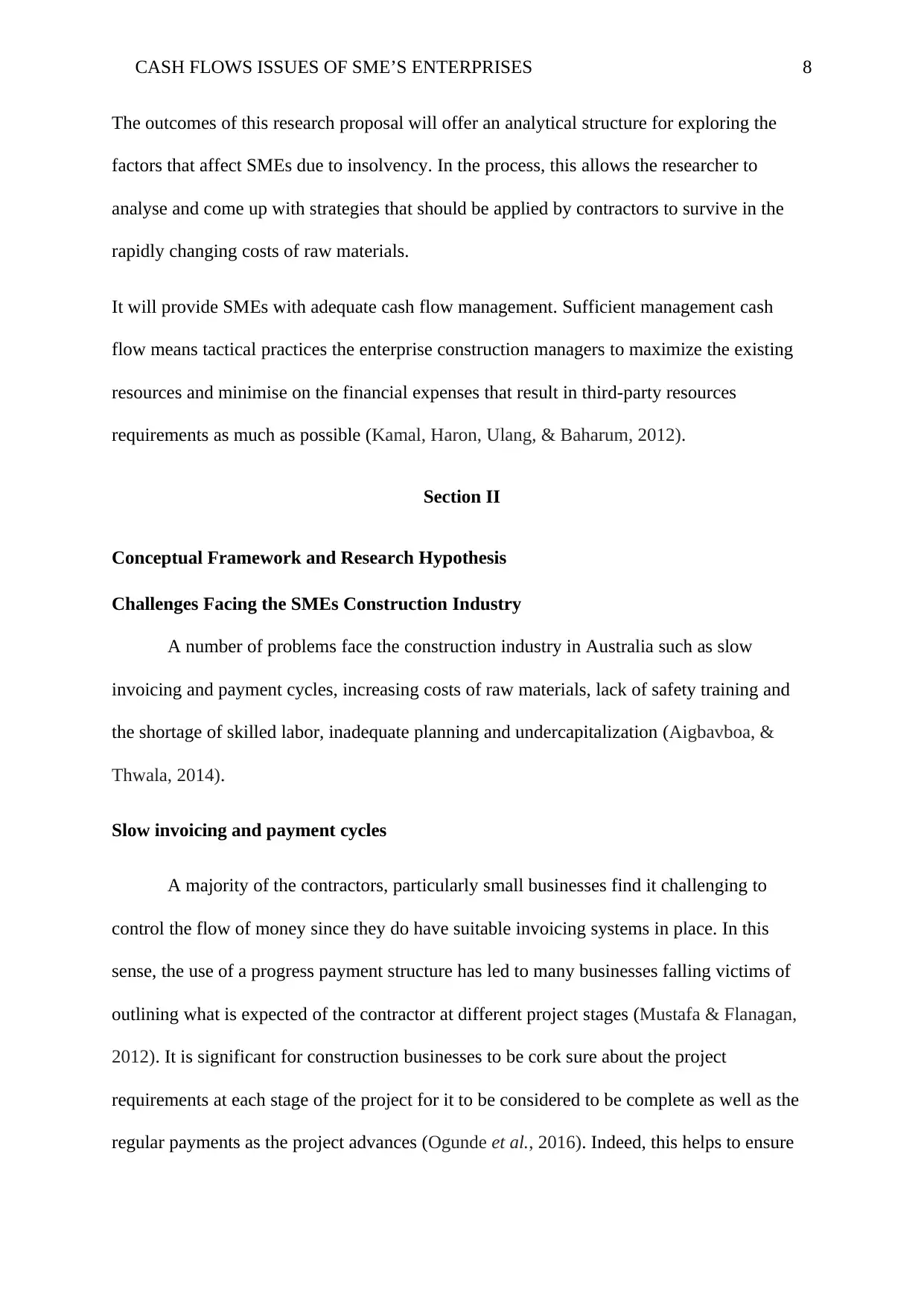
CASH FLOWS ISSUES OF SME’S ENTERPRISES 8
The outcomes of this research proposal will offer an analytical structure for exploring the
factors that affect SMEs due to insolvency. In the process, this allows the researcher to
analyse and come up with strategies that should be applied by contractors to survive in the
rapidly changing costs of raw materials.
It will provide SMEs with adequate cash flow management. Sufficient management cash
flow means tactical practices the enterprise construction managers to maximize the existing
resources and minimise on the financial expenses that result in third-party resources
requirements as much as possible (Kamal, Haron, Ulang, & Baharum, 2012).
Section II
Conceptual Framework and Research Hypothesis
Challenges Facing the SMEs Construction Industry
A number of problems face the construction industry in Australia such as slow
invoicing and payment cycles, increasing costs of raw materials, lack of safety training and
the shortage of skilled labor, inadequate planning and undercapitalization (Aigbavboa, &
Thwala, 2014).
Slow invoicing and payment cycles
A majority of the contractors, particularly small businesses find it challenging to
control the flow of money since they do have suitable invoicing systems in place. In this
sense, the use of a progress payment structure has led to many businesses falling victims of
outlining what is expected of the contractor at different project stages (Mustafa & Flanagan,
2012). It is significant for construction businesses to be cork sure about the project
requirements at each stage of the project for it to be considered to be complete as well as the
regular payments as the project advances (Ogunde et al., 2016). Indeed, this helps to ensure
The outcomes of this research proposal will offer an analytical structure for exploring the
factors that affect SMEs due to insolvency. In the process, this allows the researcher to
analyse and come up with strategies that should be applied by contractors to survive in the
rapidly changing costs of raw materials.
It will provide SMEs with adequate cash flow management. Sufficient management cash
flow means tactical practices the enterprise construction managers to maximize the existing
resources and minimise on the financial expenses that result in third-party resources
requirements as much as possible (Kamal, Haron, Ulang, & Baharum, 2012).
Section II
Conceptual Framework and Research Hypothesis
Challenges Facing the SMEs Construction Industry
A number of problems face the construction industry in Australia such as slow
invoicing and payment cycles, increasing costs of raw materials, lack of safety training and
the shortage of skilled labor, inadequate planning and undercapitalization (Aigbavboa, &
Thwala, 2014).
Slow invoicing and payment cycles
A majority of the contractors, particularly small businesses find it challenging to
control the flow of money since they do have suitable invoicing systems in place. In this
sense, the use of a progress payment structure has led to many businesses falling victims of
outlining what is expected of the contractor at different project stages (Mustafa & Flanagan,
2012). It is significant for construction businesses to be cork sure about the project
requirements at each stage of the project for it to be considered to be complete as well as the
regular payments as the project advances (Ogunde et al., 2016). Indeed, this helps to ensure

CASH FLOWS ISSUES OF SME’S ENTERPRISES 9
that refunds issued do not lead to disagreements. The contractor should be expected to make
requests for a regular payment at a specified interval of time in accordance with the project
scope. Recent studies have shown that without regular progress payments, it may be
challenging to keep up with the construction project tracking. Moreover, it makes it virtually
impossible to start another project because much of the project finances will be tied to the
project in progress. The project contractor should agree on the payment schedule, which is
appropriate for both parties to allow for the smooth running of the project from inception to
completion.
Increasing costs of raw materials
The construction materials are dynamic. In this sense, the price of construction
materials such as metal and oil keep fluctuating against the interest rates as well as the
strength of the currency of Australia. To some extent, this can be good news to contractors as
it may mean they can justify increasing their rates. Nevertheless, in case the rates go too high,
customers will end up seeking construction services elsewhere, leading to the loss of deals
(Wickramarachchi, Sandanayake, & Ekanayake, 2018). Certainly, this is a tricky problem,
which is not easy to resolve. Nonetheless, SMEs in the construction sector can try to reduce
the costs in other areas such as learning how to streamline operations by using technology as
an effective way to minimise on waste. In this case, contractors are advised to use digital
invoicing applications and record keeping software tools to boost their returns by supporting
SMEs to keep track of payments and close out faster on the project.
Lack of safety training and a shortage of skilled labor
The most recurring problem facing the Australian construction industry, particularly
SMEs. As the demand grows, it also results in the need for contractors that are qualified as
well as construction experts. As a result, this has been found to force most of the small and
medium-sized construction companies to reduce costs and attempt to increase on returns by
that refunds issued do not lead to disagreements. The contractor should be expected to make
requests for a regular payment at a specified interval of time in accordance with the project
scope. Recent studies have shown that without regular progress payments, it may be
challenging to keep up with the construction project tracking. Moreover, it makes it virtually
impossible to start another project because much of the project finances will be tied to the
project in progress. The project contractor should agree on the payment schedule, which is
appropriate for both parties to allow for the smooth running of the project from inception to
completion.
Increasing costs of raw materials
The construction materials are dynamic. In this sense, the price of construction
materials such as metal and oil keep fluctuating against the interest rates as well as the
strength of the currency of Australia. To some extent, this can be good news to contractors as
it may mean they can justify increasing their rates. Nevertheless, in case the rates go too high,
customers will end up seeking construction services elsewhere, leading to the loss of deals
(Wickramarachchi, Sandanayake, & Ekanayake, 2018). Certainly, this is a tricky problem,
which is not easy to resolve. Nonetheless, SMEs in the construction sector can try to reduce
the costs in other areas such as learning how to streamline operations by using technology as
an effective way to minimise on waste. In this case, contractors are advised to use digital
invoicing applications and record keeping software tools to boost their returns by supporting
SMEs to keep track of payments and close out faster on the project.
Lack of safety training and a shortage of skilled labor
The most recurring problem facing the Australian construction industry, particularly
SMEs. As the demand grows, it also results in the need for contractors that are qualified as
well as construction experts. As a result, this has been found to force most of the small and
medium-sized construction companies to reduce costs and attempt to increase on returns by

CASH FLOWS ISSUES OF SME’S ENTERPRISES 10
minimising on their investments in activities such as risk management processes as well as
safety training. Regrettably, this is nothing but a path to dangerous problems, which often
result in subsequent legal action (Mustapha, Aigbavboa, & Thwala, 2016). Investment in
high-quality safety training allows SMEs in the construction industry to ensure the safety of
employees and protection of the business. Technology is the best tool in the construction
industry as well as digital application and mobile devices that will ensure that training does
not become restricted to formal meetings.
Even though the construction industry is on the rise and consistently remain reliant
upon manual labor even in the edge of construction technology, Australia has a more aging
workforce. Therefore, as the construction sector keeps on growing, the industry is faced by
tough times when it comes to recruiting skilled labor force to satisfy the ever-rising demand
(Lock, 2016). To make matters worse, most of the young people in Australia in the modern
day do not regard construction jobs as profitable; hence, they opt for other careers.
Consequently, SMEs are faced with tough times because, in order to maintain the labor
forces, they have to increase on the payment. As a result, most SMEs end up spending a lot of
money on payment of employees to avoid losing the labor force, which in the process leads to
inadequate funds to service other construction operations.
Inadequate planning
Research has shown that most of the SMEs in the construction industry are faced with
cash flow problems because of insufficient planning (Abdullahi, Ibrahim, Ibrahim, &
Ahmadu, 2017). It is essential for small and medium-sized construction enterprise to set up a
great business plan, which should cater for operations, finances, and marketing of the
construction business amongst other activities. A comprehensive business plan provides
SMEs with a clear perspective of their financial flow as well as labor. In the process, this aid
the business to notice points where there are underestimations and overestimation in relation
minimising on their investments in activities such as risk management processes as well as
safety training. Regrettably, this is nothing but a path to dangerous problems, which often
result in subsequent legal action (Mustapha, Aigbavboa, & Thwala, 2016). Investment in
high-quality safety training allows SMEs in the construction industry to ensure the safety of
employees and protection of the business. Technology is the best tool in the construction
industry as well as digital application and mobile devices that will ensure that training does
not become restricted to formal meetings.
Even though the construction industry is on the rise and consistently remain reliant
upon manual labor even in the edge of construction technology, Australia has a more aging
workforce. Therefore, as the construction sector keeps on growing, the industry is faced by
tough times when it comes to recruiting skilled labor force to satisfy the ever-rising demand
(Lock, 2016). To make matters worse, most of the young people in Australia in the modern
day do not regard construction jobs as profitable; hence, they opt for other careers.
Consequently, SMEs are faced with tough times because, in order to maintain the labor
forces, they have to increase on the payment. As a result, most SMEs end up spending a lot of
money on payment of employees to avoid losing the labor force, which in the process leads to
inadequate funds to service other construction operations.
Inadequate planning
Research has shown that most of the SMEs in the construction industry are faced with
cash flow problems because of insufficient planning (Abdullahi, Ibrahim, Ibrahim, &
Ahmadu, 2017). It is essential for small and medium-sized construction enterprise to set up a
great business plan, which should cater for operations, finances, and marketing of the
construction business amongst other activities. A comprehensive business plan provides
SMEs with a clear perspective of their financial flow as well as labor. In the process, this aid
the business to notice points where there are underestimations and overestimation in relation
Secure Best Marks with AI Grader
Need help grading? Try our AI Grader for instant feedback on your assignments.
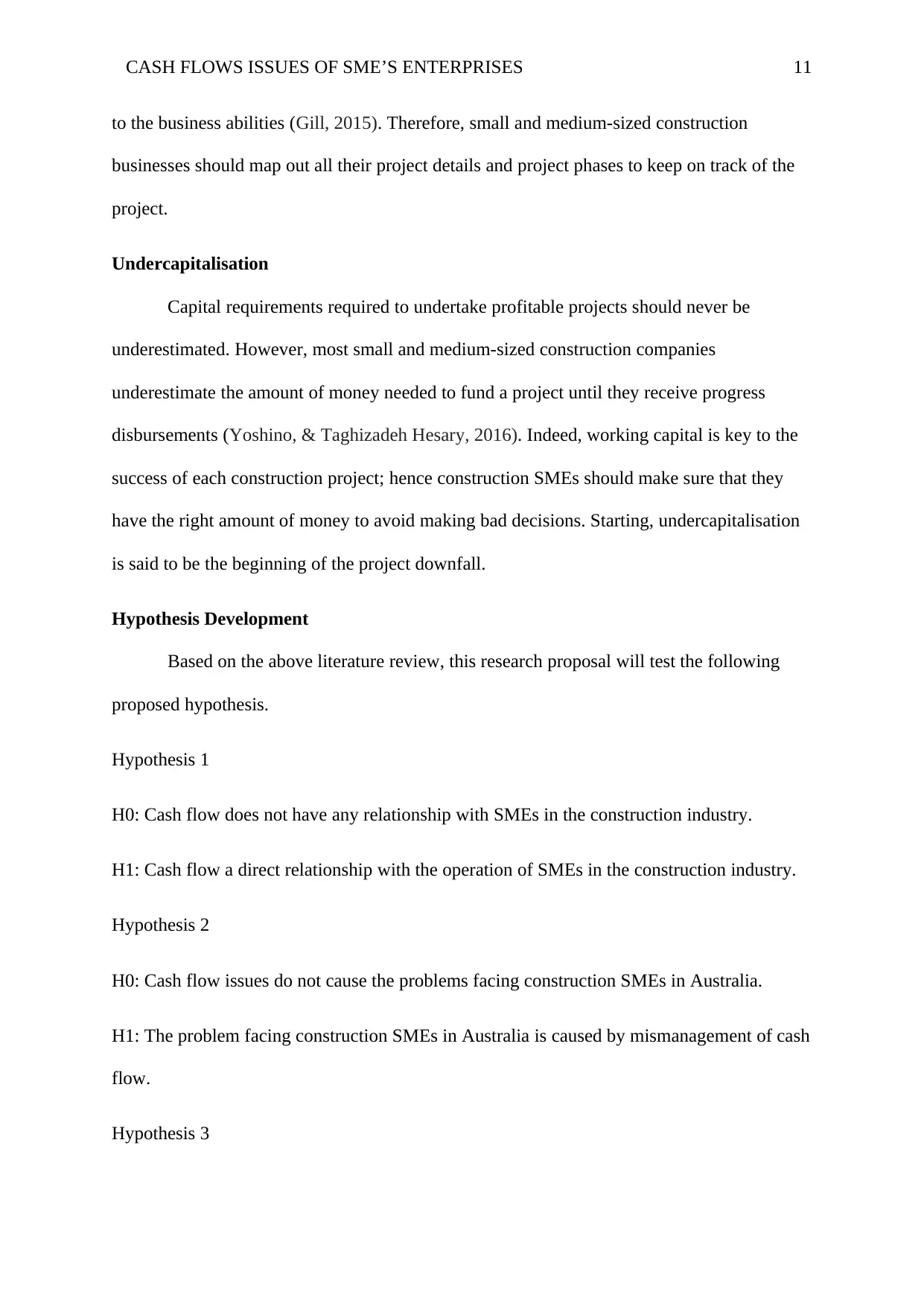
CASH FLOWS ISSUES OF SME’S ENTERPRISES 11
to the business abilities (Gill, 2015). Therefore, small and medium-sized construction
businesses should map out all their project details and project phases to keep on track of the
project.
Undercapitalisation
Capital requirements required to undertake profitable projects should never be
underestimated. However, most small and medium-sized construction companies
underestimate the amount of money needed to fund a project until they receive progress
disbursements (Yoshino, & Taghizadeh Hesary, 2016). Indeed, working capital is key to the
success of each construction project; hence construction SMEs should make sure that they
have the right amount of money to avoid making bad decisions. Starting, undercapitalisation
is said to be the beginning of the project downfall.
Hypothesis Development
Based on the above literature review, this research proposal will test the following
proposed hypothesis.
Hypothesis 1
H0: Cash flow does not have any relationship with SMEs in the construction industry.
H1: Cash flow a direct relationship with the operation of SMEs in the construction industry.
Hypothesis 2
H0: Cash flow issues do not cause the problems facing construction SMEs in Australia.
H1: The problem facing construction SMEs in Australia is caused by mismanagement of cash
flow.
Hypothesis 3
to the business abilities (Gill, 2015). Therefore, small and medium-sized construction
businesses should map out all their project details and project phases to keep on track of the
project.
Undercapitalisation
Capital requirements required to undertake profitable projects should never be
underestimated. However, most small and medium-sized construction companies
underestimate the amount of money needed to fund a project until they receive progress
disbursements (Yoshino, & Taghizadeh Hesary, 2016). Indeed, working capital is key to the
success of each construction project; hence construction SMEs should make sure that they
have the right amount of money to avoid making bad decisions. Starting, undercapitalisation
is said to be the beginning of the project downfall.
Hypothesis Development
Based on the above literature review, this research proposal will test the following
proposed hypothesis.
Hypothesis 1
H0: Cash flow does not have any relationship with SMEs in the construction industry.
H1: Cash flow a direct relationship with the operation of SMEs in the construction industry.
Hypothesis 2
H0: Cash flow issues do not cause the problems facing construction SMEs in Australia.
H1: The problem facing construction SMEs in Australia is caused by mismanagement of cash
flow.
Hypothesis 3

CASH FLOWS ISSUES OF SME’S ENTERPRISES 12
H0: Small and medium-sized construction companies do not contribute to the economy of
Australia.
H1: Small and medium-sized construction enterprises have a significant contribution to the
economy of Australia.
Hypothesis 4
H0: The cash flow issues faced by small and medium-sized construction enterprises is not
caused by poor project planning.
H1: The cash flow issues faced by small and medium-sized construction enterprises is caused
by poor project planning.
Hypothesis 5
H0: Digital apps do not cause the financial constraints faced by small and medium-sized
construction enterprises.
H1: The use of digital apps by small and medium-sized construction enterprises will help to
avoid cash flow issues in the construction industry.
Hypothesis 6
H0: The increasing cost of raw materials do not have any relationship with the cash flow
issues faced by construction SMEs.
H1: The increasing cost of raw materials has a relationship with the cash flow issues faced by
construction SMEs.
H0: Small and medium-sized construction companies do not contribute to the economy of
Australia.
H1: Small and medium-sized construction enterprises have a significant contribution to the
economy of Australia.
Hypothesis 4
H0: The cash flow issues faced by small and medium-sized construction enterprises is not
caused by poor project planning.
H1: The cash flow issues faced by small and medium-sized construction enterprises is caused
by poor project planning.
Hypothesis 5
H0: Digital apps do not cause the financial constraints faced by small and medium-sized
construction enterprises.
H1: The use of digital apps by small and medium-sized construction enterprises will help to
avoid cash flow issues in the construction industry.
Hypothesis 6
H0: The increasing cost of raw materials do not have any relationship with the cash flow
issues faced by construction SMEs.
H1: The increasing cost of raw materials has a relationship with the cash flow issues faced by
construction SMEs.
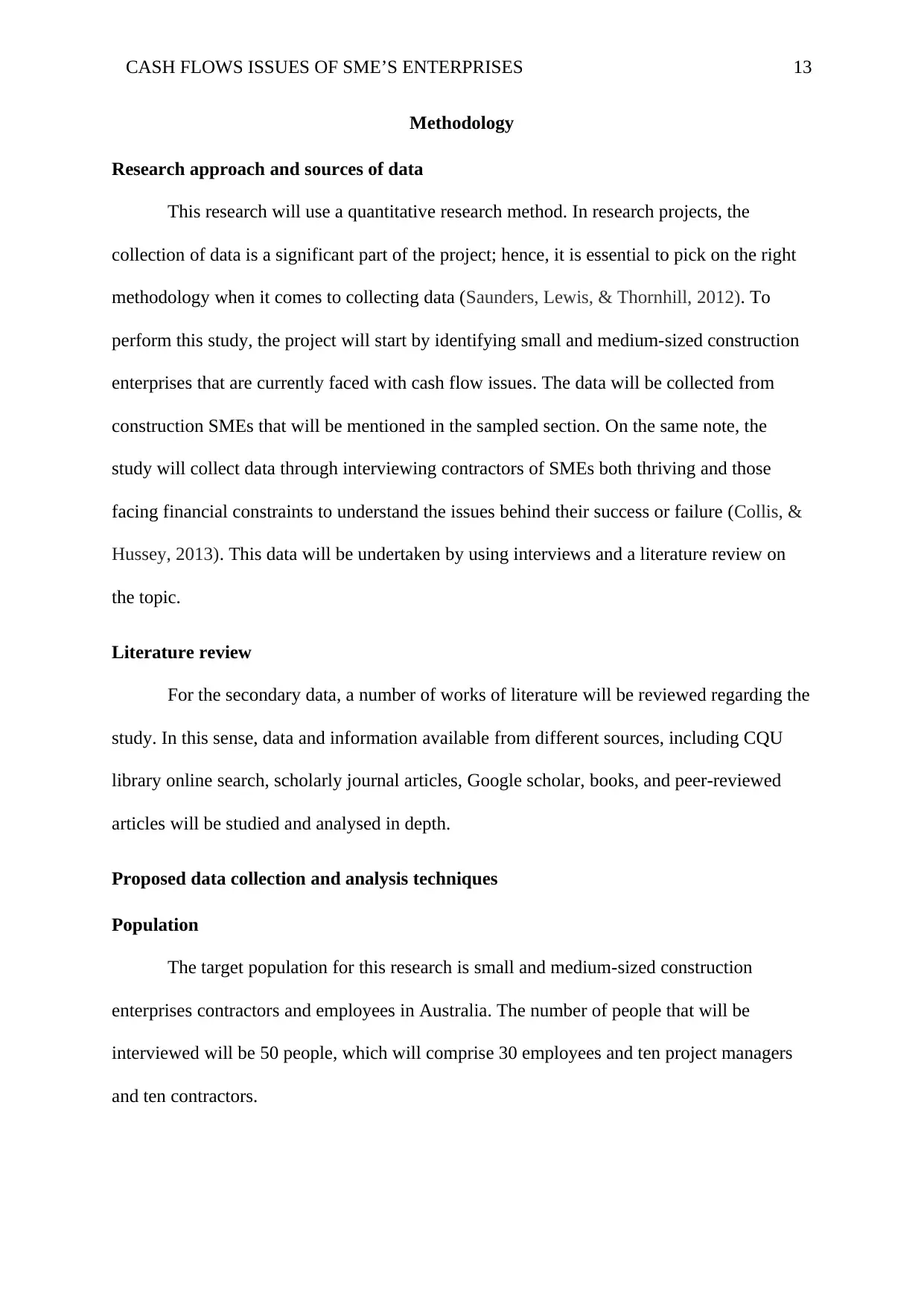
CASH FLOWS ISSUES OF SME’S ENTERPRISES 13
Methodology
Research approach and sources of data
This research will use a quantitative research method. In research projects, the
collection of data is a significant part of the project; hence, it is essential to pick on the right
methodology when it comes to collecting data (Saunders, Lewis, & Thornhill, 2012). To
perform this study, the project will start by identifying small and medium-sized construction
enterprises that are currently faced with cash flow issues. The data will be collected from
construction SMEs that will be mentioned in the sampled section. On the same note, the
study will collect data through interviewing contractors of SMEs both thriving and those
facing financial constraints to understand the issues behind their success or failure (Collis, &
Hussey, 2013). This data will be undertaken by using interviews and a literature review on
the topic.
Literature review
For the secondary data, a number of works of literature will be reviewed regarding the
study. In this sense, data and information available from different sources, including CQU
library online search, scholarly journal articles, Google scholar, books, and peer-reviewed
articles will be studied and analysed in depth.
Proposed data collection and analysis techniques
Population
The target population for this research is small and medium-sized construction
enterprises contractors and employees in Australia. The number of people that will be
interviewed will be 50 people, which will comprise 30 employees and ten project managers
and ten contractors.
Methodology
Research approach and sources of data
This research will use a quantitative research method. In research projects, the
collection of data is a significant part of the project; hence, it is essential to pick on the right
methodology when it comes to collecting data (Saunders, Lewis, & Thornhill, 2012). To
perform this study, the project will start by identifying small and medium-sized construction
enterprises that are currently faced with cash flow issues. The data will be collected from
construction SMEs that will be mentioned in the sampled section. On the same note, the
study will collect data through interviewing contractors of SMEs both thriving and those
facing financial constraints to understand the issues behind their success or failure (Collis, &
Hussey, 2013). This data will be undertaken by using interviews and a literature review on
the topic.
Literature review
For the secondary data, a number of works of literature will be reviewed regarding the
study. In this sense, data and information available from different sources, including CQU
library online search, scholarly journal articles, Google scholar, books, and peer-reviewed
articles will be studied and analysed in depth.
Proposed data collection and analysis techniques
Population
The target population for this research is small and medium-sized construction
enterprises contractors and employees in Australia. The number of people that will be
interviewed will be 50 people, which will comprise 30 employees and ten project managers
and ten contractors.
Paraphrase This Document
Need a fresh take? Get an instant paraphrase of this document with our AI Paraphraser
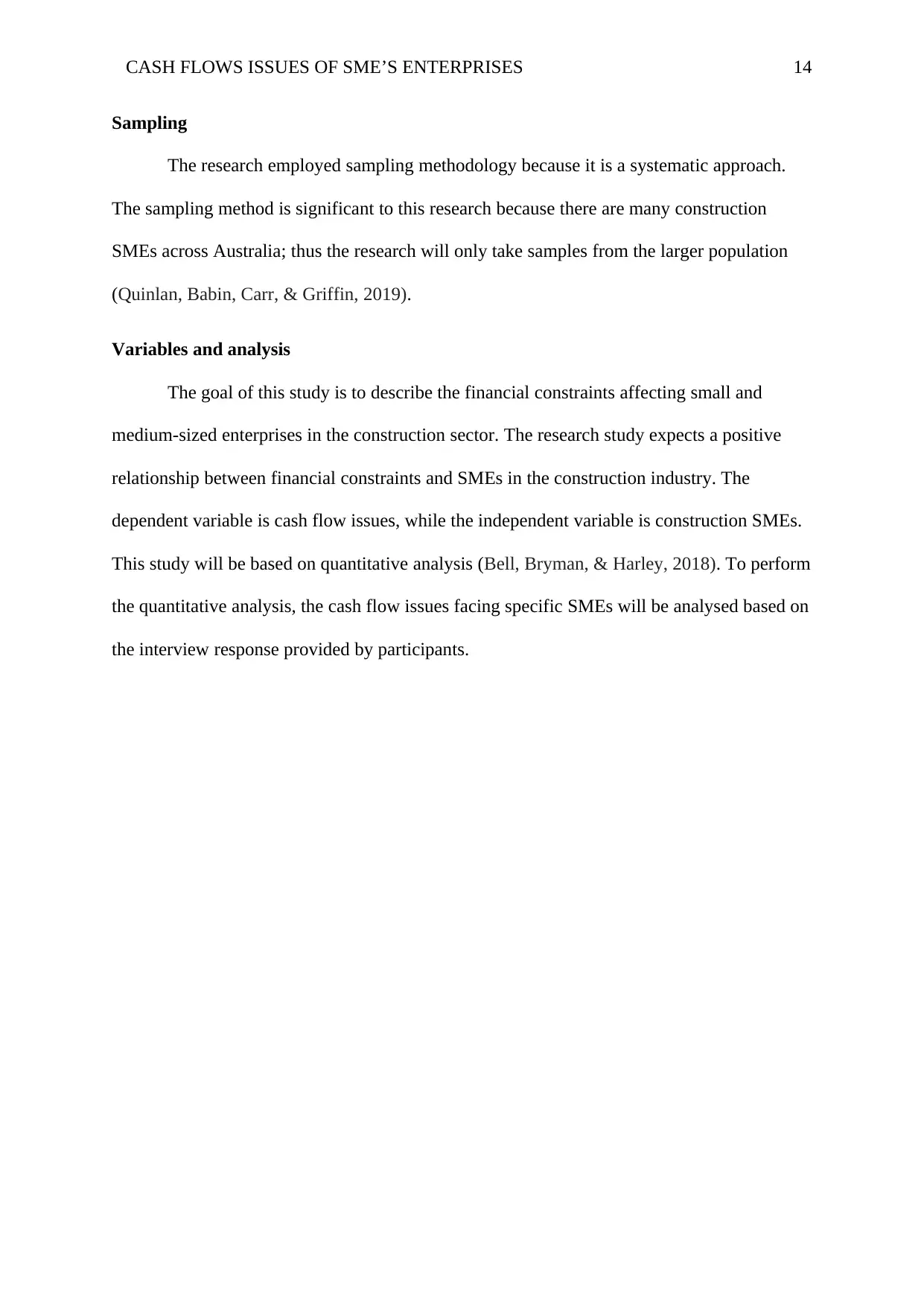
CASH FLOWS ISSUES OF SME’S ENTERPRISES 14
Sampling
The research employed sampling methodology because it is a systematic approach.
The sampling method is significant to this research because there are many construction
SMEs across Australia; thus the research will only take samples from the larger population
(Quinlan, Babin, Carr, & Griffin, 2019).
Variables and analysis
The goal of this study is to describe the financial constraints affecting small and
medium-sized enterprises in the construction sector. The research study expects a positive
relationship between financial constraints and SMEs in the construction industry. The
dependent variable is cash flow issues, while the independent variable is construction SMEs.
This study will be based on quantitative analysis (Bell, Bryman, & Harley, 2018). To perform
the quantitative analysis, the cash flow issues facing specific SMEs will be analysed based on
the interview response provided by participants.
Sampling
The research employed sampling methodology because it is a systematic approach.
The sampling method is significant to this research because there are many construction
SMEs across Australia; thus the research will only take samples from the larger population
(Quinlan, Babin, Carr, & Griffin, 2019).
Variables and analysis
The goal of this study is to describe the financial constraints affecting small and
medium-sized enterprises in the construction sector. The research study expects a positive
relationship between financial constraints and SMEs in the construction industry. The
dependent variable is cash flow issues, while the independent variable is construction SMEs.
This study will be based on quantitative analysis (Bell, Bryman, & Harley, 2018). To perform
the quantitative analysis, the cash flow issues facing specific SMEs will be analysed based on
the interview response provided by participants.
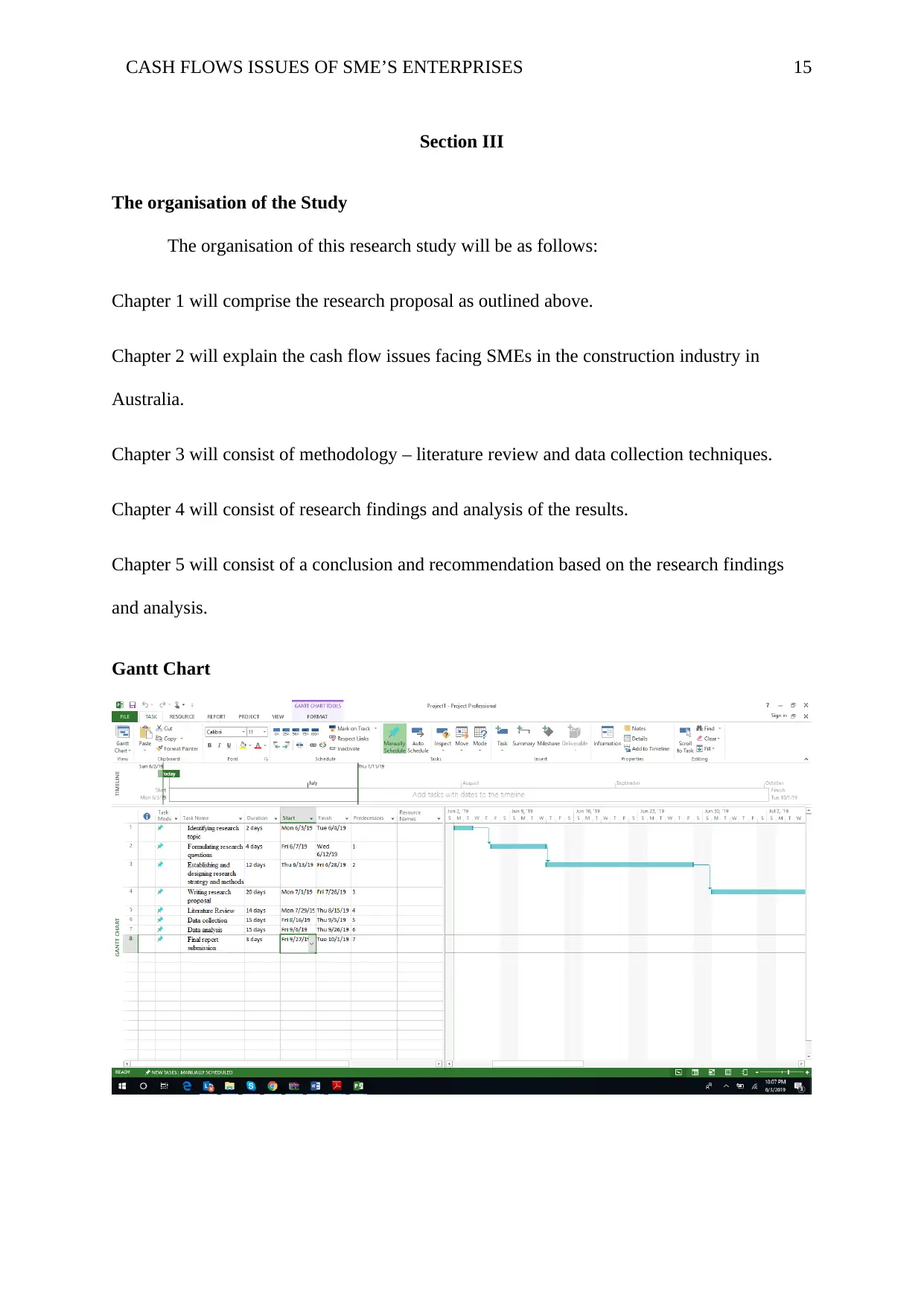
CASH FLOWS ISSUES OF SME’S ENTERPRISES 15
Section III
The organisation of the Study
The organisation of this research study will be as follows:
Chapter 1 will comprise the research proposal as outlined above.
Chapter 2 will explain the cash flow issues facing SMEs in the construction industry in
Australia.
Chapter 3 will consist of methodology – literature review and data collection techniques.
Chapter 4 will consist of research findings and analysis of the results.
Chapter 5 will consist of a conclusion and recommendation based on the research findings
and analysis.
Gantt Chart
Section III
The organisation of the Study
The organisation of this research study will be as follows:
Chapter 1 will comprise the research proposal as outlined above.
Chapter 2 will explain the cash flow issues facing SMEs in the construction industry in
Australia.
Chapter 3 will consist of methodology – literature review and data collection techniques.
Chapter 4 will consist of research findings and analysis of the results.
Chapter 5 will consist of a conclusion and recommendation based on the research findings
and analysis.
Gantt Chart
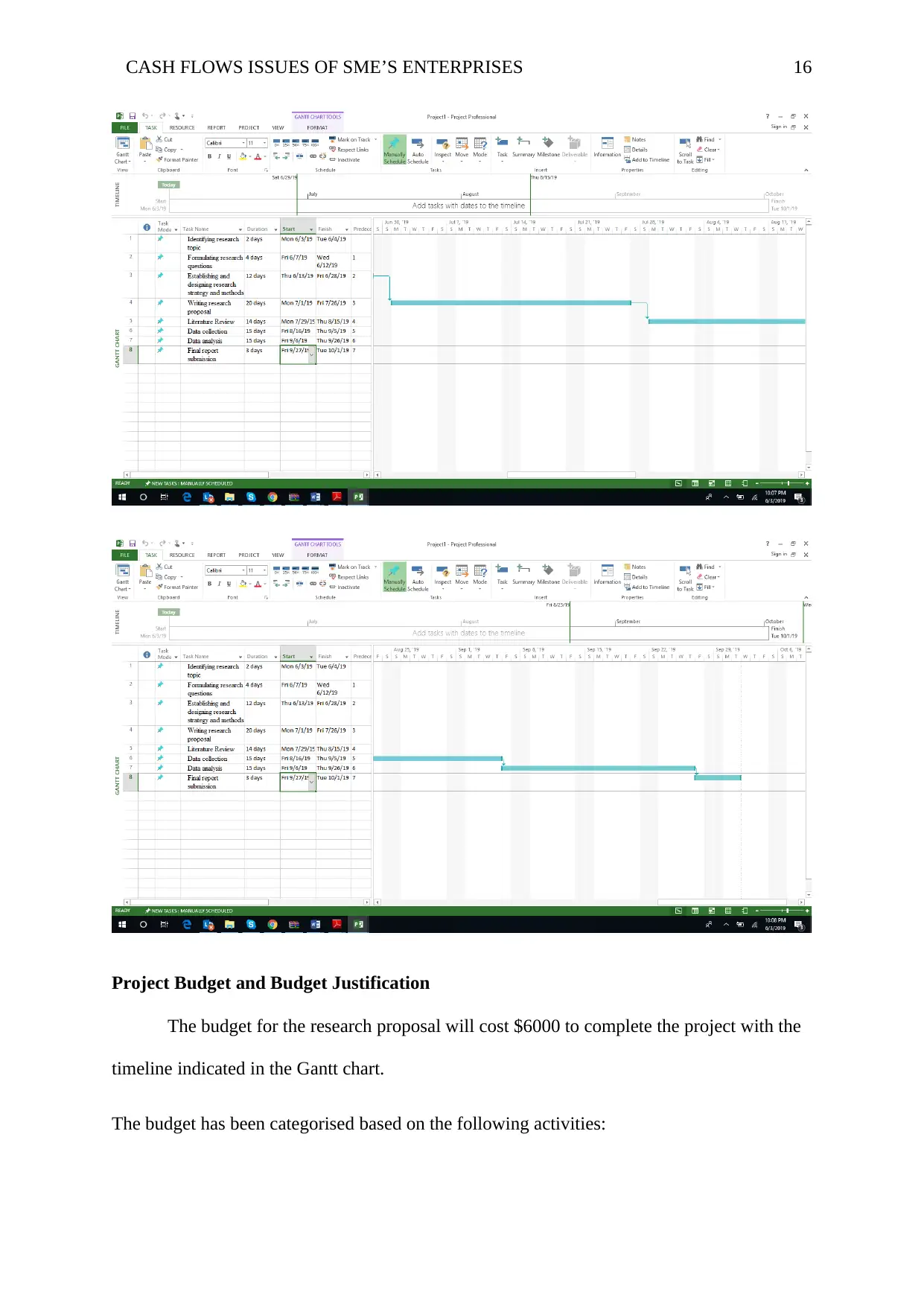
CASH FLOWS ISSUES OF SME’S ENTERPRISES 16
Project Budget and Budget Justification
The budget for the research proposal will cost $6000 to complete the project with the
timeline indicated in the Gantt chart.
The budget has been categorised based on the following activities:
Project Budget and Budget Justification
The budget for the research proposal will cost $6000 to complete the project with the
timeline indicated in the Gantt chart.
The budget has been categorised based on the following activities:
Secure Best Marks with AI Grader
Need help grading? Try our AI Grader for instant feedback on your assignments.

CASH FLOWS ISSUES OF SME’S ENTERPRISES 17
The literature review will involve the use of online resources, journals, and textbooks, which
will include some costs. The cost of this is estimated to cost $1500.
Data collection will involve traveling from one construction SME to another. It is estimated
that this process will cost $3500.
Data analysis will cost $1000.
The literature review will involve the use of online resources, journals, and textbooks, which
will include some costs. The cost of this is estimated to cost $1500.
Data collection will involve traveling from one construction SME to another. It is estimated
that this process will cost $3500.
Data analysis will cost $1000.
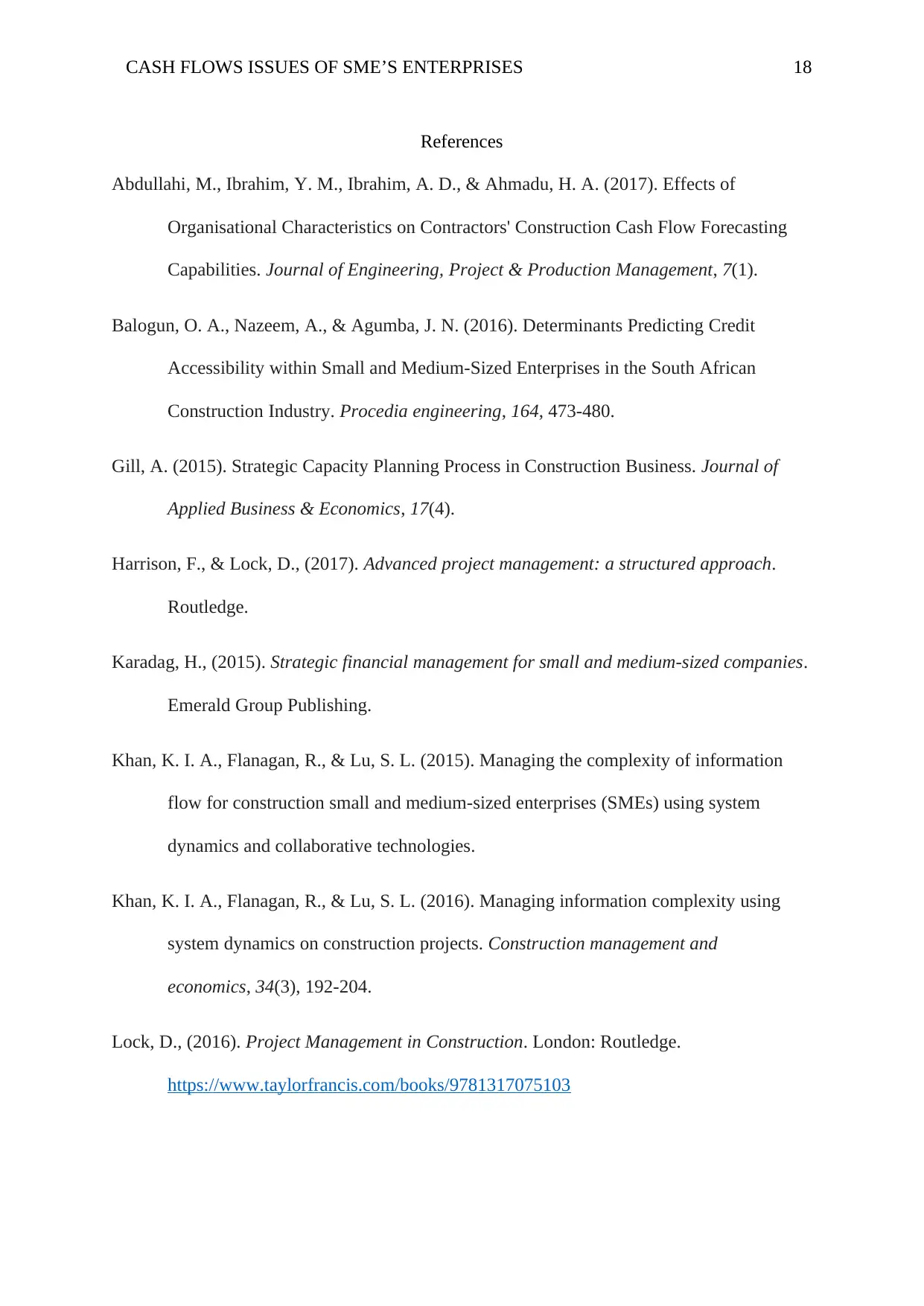
CASH FLOWS ISSUES OF SME’S ENTERPRISES 18
References
Abdullahi, M., Ibrahim, Y. M., Ibrahim, A. D., & Ahmadu, H. A. (2017). Effects of
Organisational Characteristics on Contractors' Construction Cash Flow Forecasting
Capabilities. Journal of Engineering, Project & Production Management, 7(1).
Balogun, O. A., Nazeem, A., & Agumba, J. N. (2016). Determinants Predicting Credit
Accessibility within Small and Medium-Sized Enterprises in the South African
Construction Industry. Procedia engineering, 164, 473-480.
Gill, A. (2015). Strategic Capacity Planning Process in Construction Business. Journal of
Applied Business & Economics, 17(4).
Harrison, F., & Lock, D., (2017). Advanced project management: a structured approach.
Routledge.
Karadag, H., (2015). Strategic financial management for small and medium-sized companies.
Emerald Group Publishing.
Khan, K. I. A., Flanagan, R., & Lu, S. L. (2015). Managing the complexity of information
flow for construction small and medium-sized enterprises (SMEs) using system
dynamics and collaborative technologies.
Khan, K. I. A., Flanagan, R., & Lu, S. L. (2016). Managing information complexity using
system dynamics on construction projects. Construction management and
economics, 34(3), 192-204.
Lock, D., (2016). Project Management in Construction. London: Routledge.
https://www.taylorfrancis.com/books/9781317075103
References
Abdullahi, M., Ibrahim, Y. M., Ibrahim, A. D., & Ahmadu, H. A. (2017). Effects of
Organisational Characteristics on Contractors' Construction Cash Flow Forecasting
Capabilities. Journal of Engineering, Project & Production Management, 7(1).
Balogun, O. A., Nazeem, A., & Agumba, J. N. (2016). Determinants Predicting Credit
Accessibility within Small and Medium-Sized Enterprises in the South African
Construction Industry. Procedia engineering, 164, 473-480.
Gill, A. (2015). Strategic Capacity Planning Process in Construction Business. Journal of
Applied Business & Economics, 17(4).
Harrison, F., & Lock, D., (2017). Advanced project management: a structured approach.
Routledge.
Karadag, H., (2015). Strategic financial management for small and medium-sized companies.
Emerald Group Publishing.
Khan, K. I. A., Flanagan, R., & Lu, S. L. (2015). Managing the complexity of information
flow for construction small and medium-sized enterprises (SMEs) using system
dynamics and collaborative technologies.
Khan, K. I. A., Flanagan, R., & Lu, S. L. (2016). Managing information complexity using
system dynamics on construction projects. Construction management and
economics, 34(3), 192-204.
Lock, D., (2016). Project Management in Construction. London: Routledge.
https://www.taylorfrancis.com/books/9781317075103
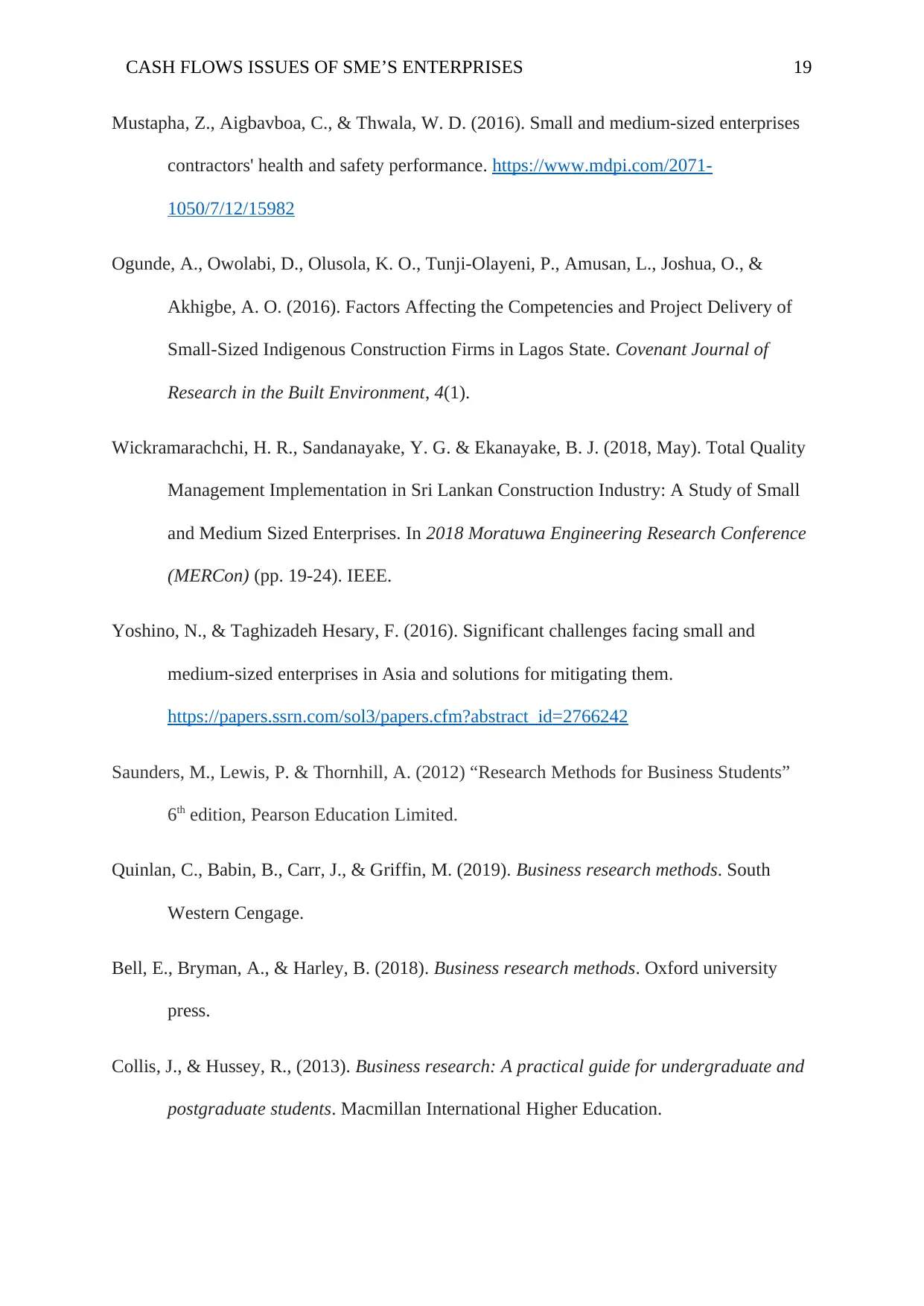
CASH FLOWS ISSUES OF SME’S ENTERPRISES 19
Mustapha, Z., Aigbavboa, C., & Thwala, W. D. (2016). Small and medium-sized enterprises
contractors' health and safety performance. https://www.mdpi.com/2071-
1050/7/12/15982
Ogunde, A., Owolabi, D., Olusola, K. O., Tunji-Olayeni, P., Amusan, L., Joshua, O., &
Akhigbe, A. O. (2016). Factors Affecting the Competencies and Project Delivery of
Small-Sized Indigenous Construction Firms in Lagos State. Covenant Journal of
Research in the Built Environment, 4(1).
Wickramarachchi, H. R., Sandanayake, Y. G. & Ekanayake, B. J. (2018, May). Total Quality
Management Implementation in Sri Lankan Construction Industry: A Study of Small
and Medium Sized Enterprises. In 2018 Moratuwa Engineering Research Conference
(MERCon) (pp. 19-24). IEEE.
Yoshino, N., & Taghizadeh Hesary, F. (2016). Significant challenges facing small and
medium-sized enterprises in Asia and solutions for mitigating them.
https://papers.ssrn.com/sol3/papers.cfm?abstract_id=2766242
Saunders, M., Lewis, P. & Thornhill, A. (2012) “Research Methods for Business Students”
6th edition, Pearson Education Limited.
Quinlan, C., Babin, B., Carr, J., & Griffin, M. (2019). Business research methods. South
Western Cengage.
Bell, E., Bryman, A., & Harley, B. (2018). Business research methods. Oxford university
press.
Collis, J., & Hussey, R., (2013). Business research: A practical guide for undergraduate and
postgraduate students. Macmillan International Higher Education.
Mustapha, Z., Aigbavboa, C., & Thwala, W. D. (2016). Small and medium-sized enterprises
contractors' health and safety performance. https://www.mdpi.com/2071-
1050/7/12/15982
Ogunde, A., Owolabi, D., Olusola, K. O., Tunji-Olayeni, P., Amusan, L., Joshua, O., &
Akhigbe, A. O. (2016). Factors Affecting the Competencies and Project Delivery of
Small-Sized Indigenous Construction Firms in Lagos State. Covenant Journal of
Research in the Built Environment, 4(1).
Wickramarachchi, H. R., Sandanayake, Y. G. & Ekanayake, B. J. (2018, May). Total Quality
Management Implementation in Sri Lankan Construction Industry: A Study of Small
and Medium Sized Enterprises. In 2018 Moratuwa Engineering Research Conference
(MERCon) (pp. 19-24). IEEE.
Yoshino, N., & Taghizadeh Hesary, F. (2016). Significant challenges facing small and
medium-sized enterprises in Asia and solutions for mitigating them.
https://papers.ssrn.com/sol3/papers.cfm?abstract_id=2766242
Saunders, M., Lewis, P. & Thornhill, A. (2012) “Research Methods for Business Students”
6th edition, Pearson Education Limited.
Quinlan, C., Babin, B., Carr, J., & Griffin, M. (2019). Business research methods. South
Western Cengage.
Bell, E., Bryman, A., & Harley, B. (2018). Business research methods. Oxford university
press.
Collis, J., & Hussey, R., (2013). Business research: A practical guide for undergraduate and
postgraduate students. Macmillan International Higher Education.
Paraphrase This Document
Need a fresh take? Get an instant paraphrase of this document with our AI Paraphraser
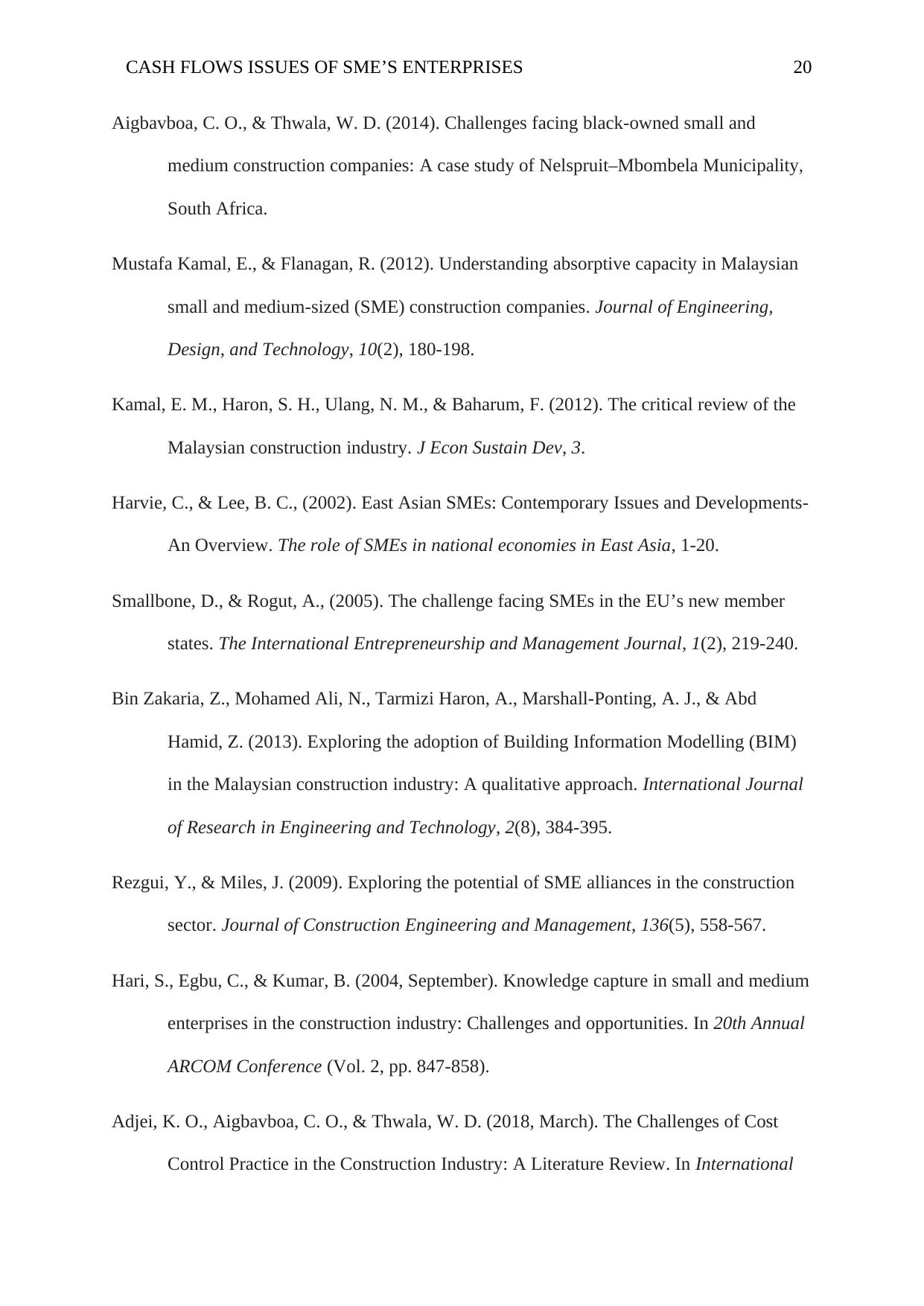
CASH FLOWS ISSUES OF SME’S ENTERPRISES 20
Aigbavboa, C. O., & Thwala, W. D. (2014). Challenges facing black-owned small and
medium construction companies: A case study of Nelspruit–Mbombela Municipality,
South Africa.
Mustafa Kamal, E., & Flanagan, R. (2012). Understanding absorptive capacity in Malaysian
small and medium-sized (SME) construction companies. Journal of Engineering,
Design, and Technology, 10(2), 180-198.
Kamal, E. M., Haron, S. H., Ulang, N. M., & Baharum, F. (2012). The critical review of the
Malaysian construction industry. J Econ Sustain Dev, 3.
Harvie, C., & Lee, B. C., (2002). East Asian SMEs: Contemporary Issues and Developments-
An Overview. The role of SMEs in national economies in East Asia, 1-20.
Smallbone, D., & Rogut, A., (2005). The challenge facing SMEs in the EU’s new member
states. The International Entrepreneurship and Management Journal, 1(2), 219-240.
Bin Zakaria, Z., Mohamed Ali, N., Tarmizi Haron, A., Marshall-Ponting, A. J., & Abd
Hamid, Z. (2013). Exploring the adoption of Building Information Modelling (BIM)
in the Malaysian construction industry: A qualitative approach. International Journal
of Research in Engineering and Technology, 2(8), 384-395.
Rezgui, Y., & Miles, J. (2009). Exploring the potential of SME alliances in the construction
sector. Journal of Construction Engineering and Management, 136(5), 558-567.
Hari, S., Egbu, C., & Kumar, B. (2004, September). Knowledge capture in small and medium
enterprises in the construction industry: Challenges and opportunities. In 20th Annual
ARCOM Conference (Vol. 2, pp. 847-858).
Adjei, K. O., Aigbavboa, C. O., & Thwala, W. D. (2018, March). The Challenges of Cost
Control Practice in the Construction Industry: A Literature Review. In International
Aigbavboa, C. O., & Thwala, W. D. (2014). Challenges facing black-owned small and
medium construction companies: A case study of Nelspruit–Mbombela Municipality,
South Africa.
Mustafa Kamal, E., & Flanagan, R. (2012). Understanding absorptive capacity in Malaysian
small and medium-sized (SME) construction companies. Journal of Engineering,
Design, and Technology, 10(2), 180-198.
Kamal, E. M., Haron, S. H., Ulang, N. M., & Baharum, F. (2012). The critical review of the
Malaysian construction industry. J Econ Sustain Dev, 3.
Harvie, C., & Lee, B. C., (2002). East Asian SMEs: Contemporary Issues and Developments-
An Overview. The role of SMEs in national economies in East Asia, 1-20.
Smallbone, D., & Rogut, A., (2005). The challenge facing SMEs in the EU’s new member
states. The International Entrepreneurship and Management Journal, 1(2), 219-240.
Bin Zakaria, Z., Mohamed Ali, N., Tarmizi Haron, A., Marshall-Ponting, A. J., & Abd
Hamid, Z. (2013). Exploring the adoption of Building Information Modelling (BIM)
in the Malaysian construction industry: A qualitative approach. International Journal
of Research in Engineering and Technology, 2(8), 384-395.
Rezgui, Y., & Miles, J. (2009). Exploring the potential of SME alliances in the construction
sector. Journal of Construction Engineering and Management, 136(5), 558-567.
Hari, S., Egbu, C., & Kumar, B. (2004, September). Knowledge capture in small and medium
enterprises in the construction industry: Challenges and opportunities. In 20th Annual
ARCOM Conference (Vol. 2, pp. 847-858).
Adjei, K. O., Aigbavboa, C. O., & Thwala, W. D. (2018, March). The Challenges of Cost
Control Practice in the Construction Industry: A Literature Review. In International

CASH FLOWS ISSUES OF SME’S ENTERPRISES 21
Conference on Applied Science and Technology Conference Proceedings (Vol. 4, No.
1, pp. 14-24).
Conference on Applied Science and Technology Conference Proceedings (Vol. 4, No.
1, pp. 14-24).
1 out of 21
Related Documents
Your All-in-One AI-Powered Toolkit for Academic Success.
+13062052269
info@desklib.com
Available 24*7 on WhatsApp / Email
![[object Object]](/_next/static/media/star-bottom.7253800d.svg)
Unlock your academic potential
© 2024 | Zucol Services PVT LTD | All rights reserved.





